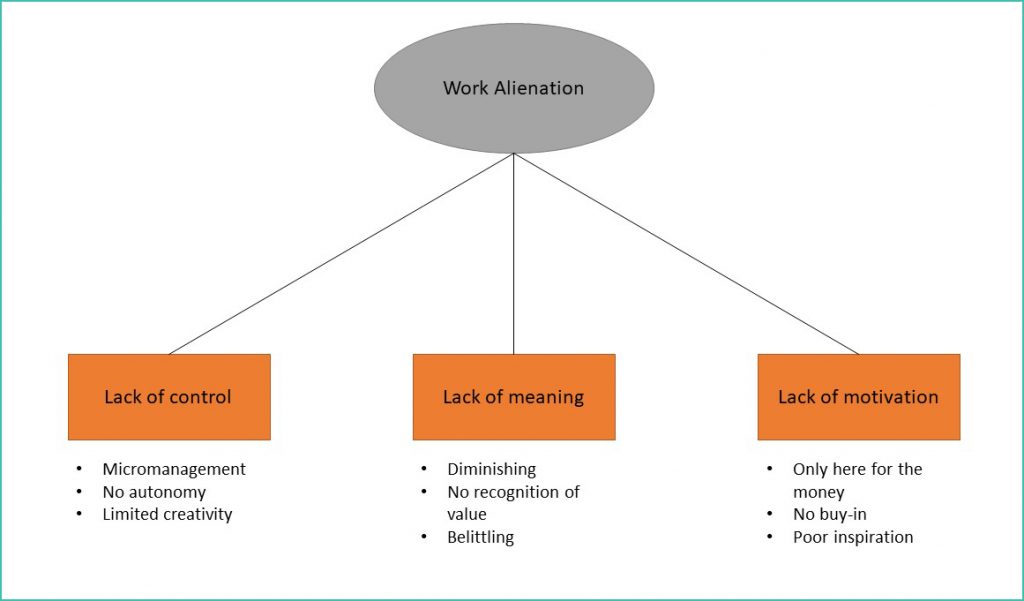Leading our teams is no easy task. Each team is made up of individuals with different motivations, communication styles, and values. It is our job as leaders to shape the values of our team, understand their motivations, and communicate with them in the best way possible. Work alienation is one of the ways we can negatively impact a strong work environment. By understanding and identifying what leaders do to increase work alienation, we can learn to mitigate its impact.
What Is Work Alienation?
Work alienation is the detachment sometimes felt by team members in their various roles. Some factors contributing to this detachment include not having control over one’s activities, lacking a sense of purpose, and not receiving internal gratification from one’s work. As the level of work alienation increases, the willingness to go above and beyond is reduced. If the detachment is strong enough or goes on long enough, it can take a “perfect fit” employee and turn them into a minimal performer. This is one of many ways poor leadership can negatively impact your team.
A feeling of powerlessness experienced by an employee can be directly tied to the level of micromanagement and direct intervention that supervisors exhibit. Even in the most repetitive tasks, you can provide your team members with a sense of power. Accomplishing this may be as simple as making slight adjustments to their work schedule to better serve customers from their perspective. Another interesting point to note is that your team members typically want to be successful and contribute not only to their personal success but to that of the team. So, by giving team members the power to positively impact their own job duties, you have the potential to positively impact the overall contribution the team makes. To throw in a buzz word, it’s a win-win.

When individuals find meaning in their work, it is easier for them to achieve the level of commitment they desire. But conveying the importance of each person’s role in the success of the organization can be challenging. Whether we work in a purely academic enterprise where the goal is knowledge transfer, or in a medical enterprise where patient care is the priority, it is our duty as leaders to ensure each member of our team understands their importance. There are different ways to accomplish this, but each requires time, attention, and communication. By talking with your team members, in a group or individually, about the impact their roles have on the organization’s overall success, you will find that they start to believe it internally.
Getting individuals to realize the value of their roles will not happen overnight, but over time it will be understood and become part of your culture. Individuals who are only working for the money are perfect examples of non-intrinsically motivated team members. These team members are also the least likely to go above and beyond their normal job duties to help the organization succeed. How do you take someone who is non-intrinsically motivated and turn them into someone who gains internal satisfaction from their work? Sometimes it is not possible, but through discussions about the meaning of their work and the power you give them over their work duties, they may come around. To put it bluntly, this type of team member is the hardest one to impact, as internal gratification is the aspect of work alienation most connected to values and motivations.
Here is a practical suggestion to incorporate work-alienation mitigation techniques into your leadership. It is not all about you. If you are in a multilevel organizational structure, work through your team level by level. Let your directors, managers, and field supervisors be the heroes by working with their teams to create ideas on how to do jobs better. As the leader of the team, you will need to support and reinforce the message, but you are now mitigating their alienation issues too. Work alienation is not only isolated to frontline or field staff.
The Importance of Values
Another interesting aspect of our teams is the different values that can be found among team members. Ideally an organization has a team whose values align with those of the organization. When this happens, it is termed value congruence, and has been found to have many positive impacts, such as stronger organizational identification, better communication, an increased climate of trust, and other beneficial work outcomes. There are two ways for leaders to influence the level of value congruence within the organization: through our efforts to shape workplace culture and through hiring.
Team members are motivated by the leaders and culture in their work environment.
Becoming a living example of your organization’s values is the first step in shaping the values of your team. As a leader, you must be an example for others to look up to. We know this sounds like one of the most basic concepts of “lead-by-example” leadership, and that is because it is. To successfully shape anyone else’s values within an organization, you will need to demonstrate those values yourself. This is not something that happens overnight and is absolutely impacted by your organization’s culture.
Hiring is another way to impact the level of value congruence between your team and the organization. During the hiring process, it is important to focus more on value-oriented discussions than on skill-based questions. Values outweigh skills in hiring, because we can teach skills, but shaping values is much more complicated. Evaluating organizational fit is often how we unknowingly rate the level of similarities between a potential hire and organizational values.
In a recent presentation we were asked a very good question: “Does looking at value congruence during the hiring process reduce the level of diversity in your organization?” The answer to this is no. Values are something that bridge many of the most common diversity focuses of gender, age, religion, race, and ethnicity. Values such as integrity, commitment, family, excellence, work-life balance, and many more are part of just about every demographic.
Understanding Your Team’s Motivations
 Members of your team are most likely motivated by different things. Motivation may come from serving and supporting others, the sense of having a purpose, recognition, or financial reward. Two simple questions to ask your team members to shed some light on these motivations are, “What do you want out of life?” and “What is your number one goal?” The answers to both questions will give you insight into how your team members are motivated. Once you understand what motivates each person, you will be able to connect with them and help them succeed. If you put enough effort into it, you will find this is a way to increase the level of internal gratification your team members feel.
Members of your team are most likely motivated by different things. Motivation may come from serving and supporting others, the sense of having a purpose, recognition, or financial reward. Two simple questions to ask your team members to shed some light on these motivations are, “What do you want out of life?” and “What is your number one goal?” The answers to both questions will give you insight into how your team members are motivated. Once you understand what motivates each person, you will be able to connect with them and help them succeed. If you put enough effort into it, you will find this is a way to increase the level of internal gratification your team members feel.
In return, share what motivates you as a leader. Being relatable and authentic strengthens connections and increases motivation. Team members are motivated by the leaders and culture in their work environment. The quality of relationships and communication in the workplace are important factors. Lack of motivation causes reduced team involvement and productivity, resulting in a negative work environment. Ultimately, the motivation of each team member drives the success of the organization.
Everyone Communicates Differently
Workplace communication is more than exchanging information and ideas within an organization. Leadership is evaluated and perceptions of colleagues are formed by observing what people say and do, and how they interact with others. Effective communication creates an environment where individuals feel heard, safe, and motivated, and in return are more productive. Two keys to effective communication are 1) understanding that everyone communicates differently, and 2) being self-aware of one’s personal communication.
If differences in communication are recognized and understood, teams are more likely to be themselves, which encourages collaboration, stimulates creativity, and provides opportunity for growth. The most effective communicators can adjust the way they communicate based on the person and situation. It is important to remember that we think, make decisions, and manage tasks differently. One person’s strength may be another person’s weakness. Recognizing individuality creates strong relationships and promotes dedication, longevity, and success.
Taking a self-assessment on social styles is a collaborative and fun way for teams to become more effective communicators. A social style (communication) assessment is based on four social styles: analytical, driver, amiable, and expressive. Most individuals will have a dominant style, but one style is not better than another. After completing the assessment, take the time to discuss the results as a group. The exercise provides an opportunity for open discussion, where individuals can break down communication barriers while building connections and trust.
Andy Krouse is director of facilities management at the University of Texas at Tyler and can be reached at [email protected]. Bonnie Davis is energy manager at UT Tyler and can be reached at [email protected]. This is their first article for Facilities Manager.
Notes from the Authors:
Andy Krouse: “This article is informed by my doctoral research and my desire to investigate the impact of poor leadership on good people. Personally, I have always felt that everyone always promotes reward programs, perks, or other mechanisms to positively impact our organizations, but no one really looks at the elephant in the room that is poor leadership.”
Bonnie Davis: “While working on my MBA, I realized I would never hold a job as a financial analyst. But what became clear is that regardless of a position or field of work, the success of any organization is based on its people and the leadership and relationships within the organization. Taking the time to invest in leadership and communication skills will positively impact the success of organizations for years to come.”



